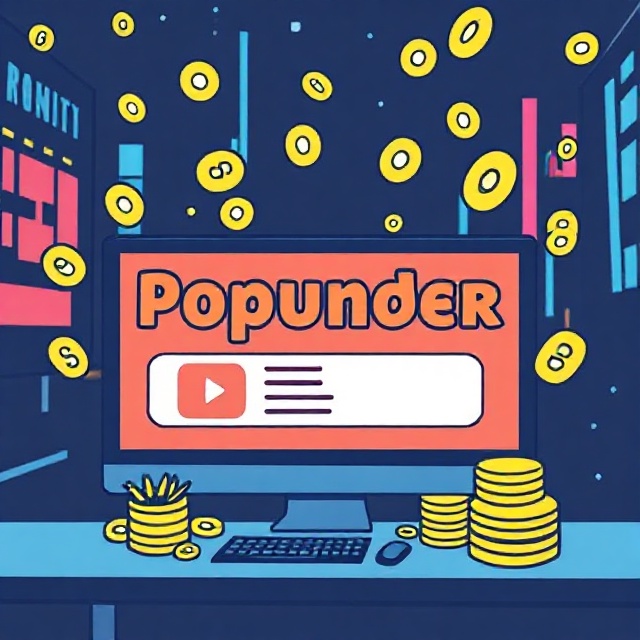Get Popunder Traffic to Increase Conversions
Popunders can raise RPM without torching UX—if you control frequency, categories, and speed. For buyers, they behave like paid visits you can micro-bid by GEO, device, and zone. This guide covers both sides: setup, math, compliant flows, landers that convert, optimization rules, and how to scale safely in 2025.
Buy nowWhat Pops/Popunders Are & How They Work
A popunder opens your landing page in a new browser tab or window behind the active one; users typically see it after they finish their current task. Pops run on desktop and mobile, and the landing page is the creative—so classic CTR isn’t the lever; performance is driven by conversion rate (CR) and source quality.
How the traffic is generated. A publisher places a script from the ad network. The script triggers a new tab/window on page load or on user interaction (scroll, click, close). On mobile, it usually opens a new tab in the same browser. Because the unit is an actual page view, every impression is a visit, so classic CTR doesn’t apply; your CR and zone quality drive performance.
Related formats. Popup (shows above the active window), clickunder (opens under the active tab on click), direct click/domain redirect (type‑in or expired domains routed to your lander), and interstitials (full‑screen in‑between pages). Use popunders for broad‑appeal offers; keep your lander fast and the first screen clear.

Who Should Use Popunder Traffic: Advertisers vs Publishers
This guide serves two roles. If you buy traffic (advertisers, affiliates, performance teams), you’ll learn how to pick networks, set bids, design landers, and optimize zones for profit. If you monetize traffic (publishers), you’ll see how to place tags, set frequency and category rules, protect UX, and raise RPM without risking complaints.

Pop Traffic Economics: How to Bid and Profit
Pops typically sell on CPM (cost per 1,000 opens). Many networks also run SmartCPM:
you set a max bid and pay the minimum price to win each source. Some platforms support CPA on selected flows, but CPM/SmartCPM is the baseline. Treat pops as paid visits: each impression is a lander view.
Core metrics
Focus on CR (visit→conversion), CPA, and zone‑level variation. EPC (revenue per click/visit) helps compare funnels. CTR is not the lever here; bid and source quality are.
Profit math (use these as guardrails)
- eCPA ≈CPM / (1000 × CR)
- Break‑even CPM ≈1000 × CR × target_CPA
Examples. If CR = 0.5% and target CPA = $5, break‑even CPM = 1000 × 0.005 × 5 = $25. If CR = 1.2% and target CPA = $3, break‑even CPM = $36. Keep bids beneath that, then raise only on whitelisted sources.
SmartCPM & micro‑bidding
Bid differently by GEO, device, and zone. Start near the network’s recommended CPM for your GEO, test spend on diverse sources, then push winners and cut the rest. Your two biggest levers are lander CR and source pruning; both improve eCPA faster than tiny bid tweaks.
Best Verticals & GEOs for Popunder Traffic in 2025
Start where your network actually has volume and where your offer is allowed. Pops are worldwide; most major networks cover hundreds of countries and all device types.
These are the verticals that consistently pair well with pop traffic.
iGaming (Betting/Casino)
Broad appeal, simple hooks (welcome bonus, live events), clear compliance boundaries. Works well with event‑driven angles (derbies, playoffs, tournaments). iGaming is regulated, so respect local laws, age gating, and network policies before you scale spend.
Dating
Low‑friction flows (sign‑up/app install), curiosity angles, age gates to filter traffic.
Sweepstakes/Contests
Prize‑driven motivation; quiz/spin pre‑landers qualify intent.
VPN/Antivirus/Utilities
Problem/solution framing (“secure connection”, “clean device”), fast landers with direct install/outbound links.
Finance (leadgen)
Rate checks, micro‑qualification. Requires strict copy and disclosures.
Media/Streaming
Instant gratification; highlight content access and device compatibility.
How to Build Popunder Landing Pages That Convert
In pop traffic the landing page is your creative. People land on a full page, not a tiny ad. Win the first screen and keep friction low.
What to optimize first
Prioritize these essentials.
- Above the fold: one promise, one proof point, one CTA. No competing actions. Keep copy clear and specific.
- Load speed: strip heavy scripts and animations; compress images; test on mid‑range Android.
- Mobile first: large tap targets, short forms, working autofill and consent checkboxes.
Pre‑landers that work
These pre‑landers reliably lift intent.
- Quiz/checker: 2–4 taps to “qualify” (age, location, device, interest). Shows progress and removes doubt.
- Spin‑wheel/instant reveal: controlled randomness to surface the offer; cap retries and show clear terms.
- Age gate (18+/21+): required for dating/gambling in many GEOs; keeps copy policy‑safe and sets expectations.
- System‑style prompts: use carefully; avoid deceptive UI. Prefer honest benefit‑led copy.
Direct vs pre‑lander
Go direct when intent is obvious and the offer page is fast and clear. Use a pre‑lander to warm up cold traffic, explain value, or filter out low‑intent visitors before the main form/install.
QA checklist
Run through this before you enable traffic.
- Pixel/postback fires on the right event; test conversion end‑to‑end.
- Above‑the‑fold renders correctly on top devices and browsers.
- Forms validate smartly; errors are readable; privacy/terms visible.
- Bounce tests: if time‑to‑first‑click is high, simplify the hero and reduce options.
What About Compliance & UX in Pop Ads?
Use these rules to keep performance rising.
How to Launch Popunder Ads in 10 Steps
- Choose one offer and one KPI. Pick a single flow and define success (target CPA or ROAS). Write the one‑sentence promise for your first screen.
- Pick the network and enable source transparency. Use a platform that exposes zone IDs and supports postbacks and SmartCPM. Ask for recommended CPM by GEO.
- Split by GEO and device. Start with one GEO and one device family (e.g., mobile Android). Create separate campaigns when behavior differs.
- Frequency cap and daypart. Begin with 1–2 impressions per user/day. Run during local evenings for consumer offers; adjust after the first 48 hours.
- Bids and budget. Set SmartCPM near the network's recommendation for your GEO. Cap the daily budget to gather ~1,000–2,000 visits (enough to see CR patterns) before changes.
- Wire tracking and QA. Add UTM to every final URL. Map postback fields (click ID, payout, status). Fire a test conversion and verify it in both systems.
- Launch broad, tag sources. Start with the network's mainstream sources. Pass subIDs/zone IDs to your tracker.
- First 24–48 hours: prune hard. Pause the bottom 20–30% zones by CR/eCPA. If eCPA is high everywhere but bounce is low, lower friction on the lander instead of raising bids.
- Build a whitelist. Keep only sources with stable CR and eCPA under your break‑even CPM math. Duplicate the campaign to a whitelist with slightly higher bids.
- Iterate the lander. Pops equal visits; your biggest lever is CR. Change the hero, tighten copy, shorten forms, and test a pre‑lander if direct is weak.
Sanity math
- eCPA ≈CPM / (1000 × CR)
- Break‑even CPM ≈1000 × CR × target_CPA
Keep bids below break‑even CPM and optimize CR first.

Optimization & Scaling
Use these rules to keep performance rising.
Source hygiene. Review performance at zone level daily. Blacklist outliers (very low CR / suspiciously high volume with zero events). Promote winners.
Micro‑bidding. Set different CPMs by GEO, device, and zone tiers. Use SmartCPM to clear auctions cheaper while still winning quality supply.
Automation. Create rules: pause zone after N visits with CR below X or eCPA above target; raise bid +10–20% on zones with eCPA 20% under target for M visits; daypart off‑hours with poor CR.
Lander refresh. Treat lander like creative. Refresh hero image, headline, CTA, and proof. Keep the angle; change the surface.
Pre‑lander logic. Use a short quiz/checker to lift intent (age, location, interest). Cap steps to 2–4. Show progress and terms.
Analytics. Track by subID (zone/source), device, browser, and time‑of‑day. Compare EPC and eCPA. Keep a spreadsheet of whitelist candidates and their stable bids.
When to scale. Only after a week of stable eCPA under target across multiple sources. Scale by duplicating to new GEOs/devices and slowly widening source tiers.
How to Monetize with Popunders Without Losing Users
Popunder monetization works when revenue grows and users keep coming back.
Setup
Integrate the network’s tag and verify it fires only on pages you allow. Test both on‑load and on‑interaction triggers (scroll/click/exit) and pick the milder option.
Keep Core Web Vitals intact: delay heavy scripts, avoid blocking the main thread, and don’t fire multiple pops per visit.
Enable category rules to block sensitive ads by GEO (e.g., adult, gambling where restricted). Use allowlists of trusted advertisers if available.
Frequency & placement
Start conservative and expand only if UX stays healthy.
Begin with 1 popunder per user/day; test 2/day only if complaint rates and bounce stay stable. Suppress on sensitive pages (legal/checkout/login).
Provide a visible opt‑out or “fewer ads” preference where your CMP/UX allows it. Respect consent choices.
Policy & safety
Keep users safe and partners happy.
Do not combine popunders with platforms that prohibit them (e.g., certain ad exchanges/partners). Keep monetization stacks separate.
Use networks with malware filters and real‑time blocking. Report bad creatives with zone/flight IDs for removal.
Revenue optimization
These tweaks add revenue without hurting UX.
Set a floor CPM and configure passbacks for unsold impressions. Consider multi‑network mediation but cap the number of hops to protect speed.
Track RPM, bounce, time on site, pages per session, and complaint rate. Optimize for net revenue per 1,000 sessions, not just raw CPM.

Conclusion
Popunder traffic turns impressions into visits, so the winners obsess over lander CR and source quality. Keep bids under your break‑even CPM, cap frequency at 1–2/day, and cut weak zones in the first 48 hours. Once your whitelist holds a stable eCPA under target, duplicate to new GEOs/devices and raise caps carefully. That’s how you make money with pops in 2025 without burning budget.
Buy popunder traffic